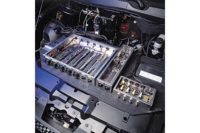Aluminum wire and cable can be more difficult to feed, cut, crimp, strip and splice than its copper counterparts. However, numerous processing methods are currently under investigation.
Aluminum wire and cable can be more difficult to feed, cut, crimp, strip and splice than its copper counterparts. However, due to growing applications for aluminum wire harnesses, numerous processing methods are currently under investigation.
As the industry standard, copper wire and cable can be processed using a wide variety of easy to use and maintain equipment. “Aluminum is a different product that requires careful selection of processes and new equipment to be added,” says Fred Kelley, engineering director at Prestolite Wire LLC. “Limited investment availability has delayed or prevented the purchase of capital equipment required for aluminum wire and cable processing.
“Due to aluminum oxide challenges, [aluminum wire may] require robust metallurgical terminations or welding in an oxygen-free environment,” adds Kelley. “Splicing aluminum to copper must also be carefully completed, due to dissimilar metals and galvanic corrosion concerns.”
Aluminum wire can be cut and stripped easily. However, crimping must be carefully designed using the correct components and processes.
For instance, aluminum tends to flow when put under static pressure. “So, if a terminal is crimped around it, the metal would flow out the front and back, thereby making the volume inside the crimp less,” notes Rob Boyd, crimping product manager at Schleuniger Inc. “Eventually, the crimp loosens and loses mechanical strength.” It also invites oxidation and corrosion.
“Oddly enough, crimp compaction is typically much higher with aluminum wire,” adds Boyd. “In other words, the crimp on an aluminum wire is much tighter than on a copper wire of the same size; hence, more pressure. To combat this, some manufacturers utilize a two-level crimping process to maximize electrical conductivity and mechanical strength.”
Terminals for aluminum wire often have differences in crimp wing design to accommodate a different crimping process. “Without some other means, the terminal must be designed to break up or break through the oxidation on the wire to form a good connection,” Boyd points out. “Consequently, there are not many terminals that are approved for small aluminum wire.
“Furthermore, special terminals require special crimp tooling and possibly special applicators,” explains Boyd. “Numerous crimping methods are under investigation, but different manufacturers prefer different processes. Each method requires extensive time and research to prove out because the only way to truly verify the system is with time.”
Aluminum wire also requires different testing procedures. “With a copper conductor crimp, a micrograph (or cross section) can be made to quickly and easily see the quality of the crimp from the inside,” says Boyd. “It is easy to make sure that there are no voids in the crimp and that all of the strands have been deformed.
“Since the compaction of the aluminum crimp is so much more, using these basic measures it will always look like a good crimp, with no voids and all strands deformed,” warns Boyd. “The only way to know if an aluminum crimp will stand the test of time is with expensive test equipment, many different tests and time. Of course, all of the quality measurement practices were created based on history and what we have learned. Since we have no history on aluminum wire processing, we still have much to learn.”
Get our new eMagazine delivered to your inbox every month.
Stay in the know on the latest assembly trends.
SUBSCRIBE TODAY!Copyright ©2024. All Rights Reserved BNP Media.
Design, CMS, Hosting & Web Development :: ePublishing

